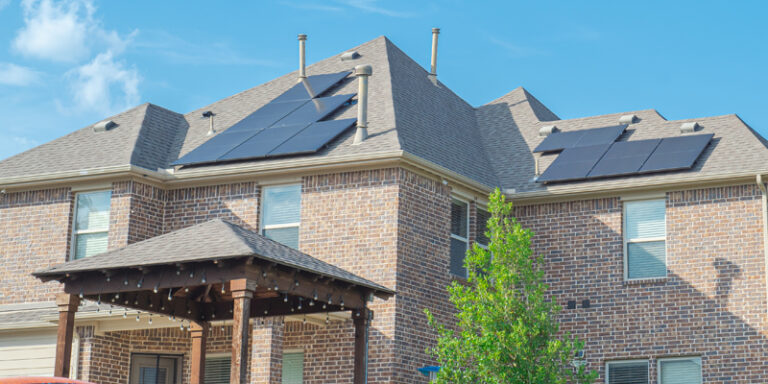Heavy ice accumulation caused significant damage during Winter Storm Mara

PEC crews weathered extreme ice and worked through immense, widespread damage to infrastructure across the 8,100-square mile service territory during Winter Storm Mara. Through the damage and difficult terrain, the effects of this weather event were like nothing we’ve ever seen before.
The storm’s damage led to a peak of around 76,000 meters without power on Thursday, February 2, and over 98,000 individual location outages over the total course of the storm’s restoration efforts. Hays County peaked at 8,790 members out as of 8:30 a.m. on February 2, and Travis County peaked at 11,741 member outages at 1 p.m. on February 2. To restore service and address the needs of our members, crews and staff worked around the clock for multiple days and were able to restore power to the entire membership in just a week.
“Where with Winter Storm Uri in 2021 we saw snow and lack of generation on the system, this storm brought significant impact to the infrastructure,” said PEC Chief Operations Officer Eddie Dauterive. “We had significant ice on the system.”
Dauterive also noted that while our system has significantly improved since a similar storm occurred in 1997, the heavy ice accumulation and vegetation debris led to more damage on PEC lines. After Winter Storm Uri in 2021, for example, we replaced four poles in Oak Hill. During Winter Storm Mara, we replaced 98 poles in Oak Hill.
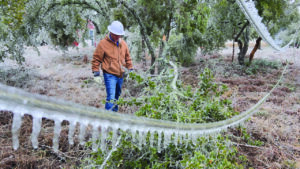
Tuesday, January 31
Periods of freezing rain and sleet began to move into the area and intensified overnight Tuesday. Outages were in the 200-300-meter range throughout the day but grew substantially when non-PEC equipment went down.
Transmission damage became the source of 90% of the outages. Our operations control center monitored the system 24/7 and agents in our call center continued to support members by phone.
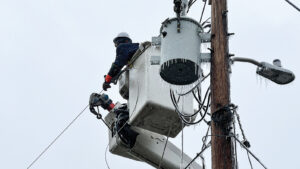
Wednesday, February 1
Crews worked swiftly to assist the owner of the equipment, and one substation was restored early Wednesday morning. A significant number of outages were restored Wednesday morning.
That afternoon, 95% of our members had power. A total of 12,500 outages were reported in the morning and 18,900 in the evening.
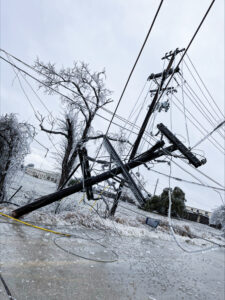
Thursday, February 2
Once the damage from accumulated ice was starting to mount, PEC leadership quickly activated our Emergency Operations Plan, which initiated an all-hands-on-deck emergency response for all departments. All lineworkers in the field had been working around the clock since the beginning of the storm.
Later Thursday, PEC staff were alerted that the Electric Reliability Council of Texas (ERCOT) ordered the Lower Colorado River Authority (LCRA) to initiate a temporary outage in the Seward Junction area due to energy transmission congestion. This didn’t last long, but PEC had no control of the outage or its duration. While outages were in the 40,000-50,000 range through Thursday evening, all substations were restored Thursday night and into early Friday morning.
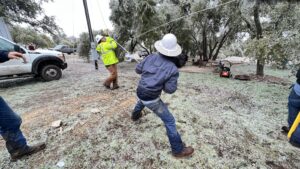
Friday, February 3
As outages began to backlog the outage map on our website — which is not the map monitored by our SCADA control center — the software’s predictive mechanism couldn’t accurately report estimated restoration times or number of crews assigned. This is because the mechanism predicts restoration times based on typical outages and not on those in a unique weather event.
We also had “disappearing outages,” where an outage was not seen by a member on the external map. When multiple individual outages are reported in an area, the map links those outages together as a single, larger outage represented by a polygon. If a member reports an outage in an area that has already been identified, their individual outage will not appear on the outage map but will become part of the existing polygon.
When viewing the map on a mobile device, it zooms into the outage area, making the polygon difficult to recognize. For members, this caused difficulty in recognizing individual outages.
On Friday, February 3, we published updates on our website and sent targeted emails and text messages to impacted members. This included members Liberty Hill, Bertram, Oak Hill, and Canyon Lake.
To communicate “disappearing outages,” we developed a manual workaround to identify outages that remained after larger, rolled-up outages were restored. When outages were cleared, emails and texts were sent to members letting them know a large outage in their area had been restored and if they were still without power, to report it to 25022 or call the outage hotline at 888-883-3379.
We provided updates and safety information with members on social media. Member relations agents continued to speak with members by phone.
Along with winter storm-related challenges, lineworkers were called upon for additional elements out of our control. On Friday evening, an 18-wheeler took out six poles just before we re-energized a large outage in Henly. This required an additional 36 hours to get power restored because crews had to come back to replace the damaged infrastructure.
Crews worked swiftly through this challenge, and as of Friday evening, restoration again improved to 21,800 outages.
Saturday, February 4
More of our members woke up with power Saturday morning. Overnight work led to having 12,700 members without power, a 9,100-member improvement from Friday night.
While crews continued to work hard, it didn’t come without a whirlwind of challenges. Many poles were down and lines were broken, which required miles of line to be rebuilt. Even as crews made repairs, it wasn’t uncommon for the weight of the ice to cause damage within the same area. On Saturday, the remaining outages across PEC’s 8,100 square-mile service area were increasingly complex due to downed trees and branches. The difficult and often isolated terrain contributed to the complex repairs. These outages also required many crews and materials to restore wire, fix poles, and clear vegetation. In some instances, the terrain was so difficult to access that crews had to hike in equipment.
“Our crews are holding strong and giving their all, every day and night, to make sure the lights get back on for every one of our PEC members” PEC Director of Operations for Oak Hill Michael Hansen said on Saturday.
In addition to PEC’s 252 PEC lineworkers throughout the event, we also had 464 contract workers who assisted us in restoration. We were very appreciative of the help from other utility companies who stepped in to help.
In the late hours of Saturday, after completing restoration in Liberty Hill, a private vehicle struck a pole and brought down a 600-amp riser that knocked out power once again to more than 5,000 meters. Later that night, crews were able to install a new pole and get the meters back online.
Also on Saturday, another private vehicle accident in Leander caused a service interruption that affected more than 4,800 meters. These incidents prompted our posts on social media reminding members to move over and slow down to 20 mph below the posted speed limit when they see utility vehicles parked on the side of the road.
Thanks to the collaborative effort from every PEC department involved, more progress was made, leading to just 8,800 members’ power left to be restored.
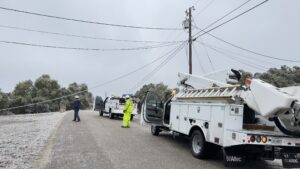
Sunday, February 5
Outages were nearly cut in half overnight, as 4,600 members were left to be restored.
“Many districts are very close to completion of storm-related outages and are preparing to release or transition contract crews to other districts, or release them from other utilities,” Dauterive said. “In these districts, design and planner staff continued supporting other districts by guiding contract crews or verifying outage data in the district command rooms.”
Communication with members continued to be strong, as an updated message to members with long outages was distributed again Sunday afternoon. Staff remained positive about the day, as fewer new issues were being reported, and crews began to see a more complete picture of all locations in the field that still needed restoration.
As of Sunday evening, around 3,500 members remained without power.
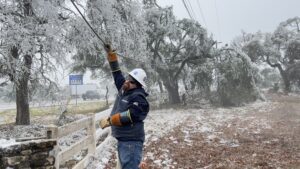
Monday, February 6
The 1,000 outages remaining were the most challenging to repair, but crews were ready and willing to navigate the difficult terrain. All remaining outages were pinged and verified on the map as active. With updated data, our control center had a clearer picture of the work remaining.
For our member relations team, the updated estimated times of restoration from the field were an enormous help when speaking with members. Our crews in the field could shorten their shifts allowing them to get rest.
By Monday evening, we had reached the end of major restoration work, and what was left were individual outages in remote areas. There was a concern about rain and wind coming from possible thunderstorms, but there was minimal impact. As of Monday evening, 850 outages were left.
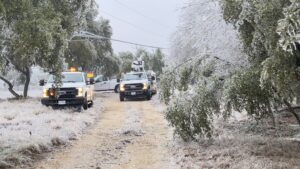
Tuesday, February 7
Incredible work continued overnight, leading to a 790-member restoration – now only 60 outages left. That number was cut in half throughout the day, leading to 30 members left to be restored.
Next steps
Staff has already begun reviewing our operations through this storm, and we are adjusting our plans to serve members even better in future emergencies. This storm brought unique challenges, and it is our responsibility to learn from them.
First and foremost, we plan to refine our outage management system. We are also scheduling additional flyovers in April to capture the impact of the storm and reprioritize maintenance as needed. Technology has proven valuable in supporting PEC’s system; it provides cost savings from previous approaches to system maintenance.
There is a strong likelihood that many of PEC’s damaged poles were due to vegetation pulling on communication lines attached to PEC poles. Staff is investigating and will have further analysis in future updates. We will also continue to provide education about the necessity of vegetation management for your electric service.
We also plan to automate the Two-Way Automatic Communication System (TWACS) meter ping process. PEC’s Advanced Metering Infrastructure (AMI) meters will support enhanced automation as more are deployed to every member.
As of now, PEC remains in recovery operations. Crews are cleaning the sites of damaged equipment, repairing equipment, and reactivating protective services. Staff is analyzing data, and completing damage assessments for pole contacts, member claims, and state and local requirements. Management is preparing an after-action assessment for improvement.
It remains our mission to provide reliable, low-cost service to our membership.

